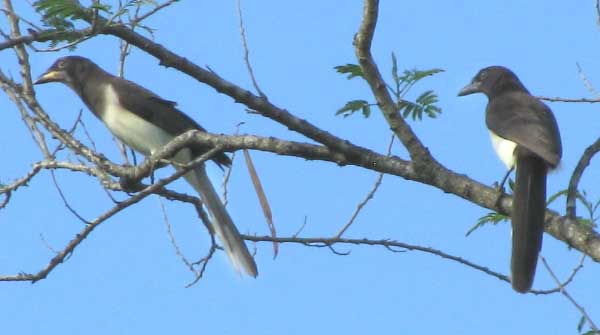Excerpts from Jim Conrad's
Naturalist Newsletter

from the January 23, 2011 Newsletter issued from Hacienda Chichen Resort beside Chichén Itzá Ruins, central Yucatán, MÉXICO; limestone bedrock, elevation ~39m (~128ft), ~N20.676°, ~W88.569°
BROWN JAYS, MERCILESSLY
Our common jay species here -- really common -- is the bland and blue Yucatan Jay, which is endemic just to the Yucatán. Next common, usually spotted every day if you're paying attention, is the Green Jay, a denizen of scrubby lowlands from southern Texas to Bolivia. The least common species is the Brown Jay. It's absent most of the time, but occasionally small flocks drop by, and then you hear them before you see them. You can see a couple above.
That's a borderline immature on the left, borderline because the beaks of fully immature Brown Jays are completely yellow, and they have yellow eyerings (just like immature Yucatan Jays, interestingly, though otherwise they're very different), and you can see that this bird's beak is splotchy black and yellow, and the yellow eyering has almost disappeared. Those of you who know Texas's Brown Jays will recognize that our birds have much whiter bellies than the Texas ones. Texas is home to the "dark morph" while here in the Yucatan we have the "light morph."
These are fairly large birds. North America's Blue Jay is ten inches long (25cm), as are the Scrub and Gray Jays. Yucatan Jays are 13 inches (33cm), but Brown Jays are 16 inches (41cm).
If you know jays in general, you already know how this bird behaves -- nosey, nervous and noisy. In "A Guide to The Birds of Mexico and Northern Central America," author Howell in his description of the Brown Jay's voice hints at what surely was a jillion times when he was sneaking up on a bird while working on his book, and Brown Jays came calling the alarm, scaring his quarry off. Howell describes the jay's call as "Monotonous and obnoxious, an all-too-soon familiar loud screaming kyeeah! or k'yaah! and kaah! kaah!, etc., often repeated mercilessly."